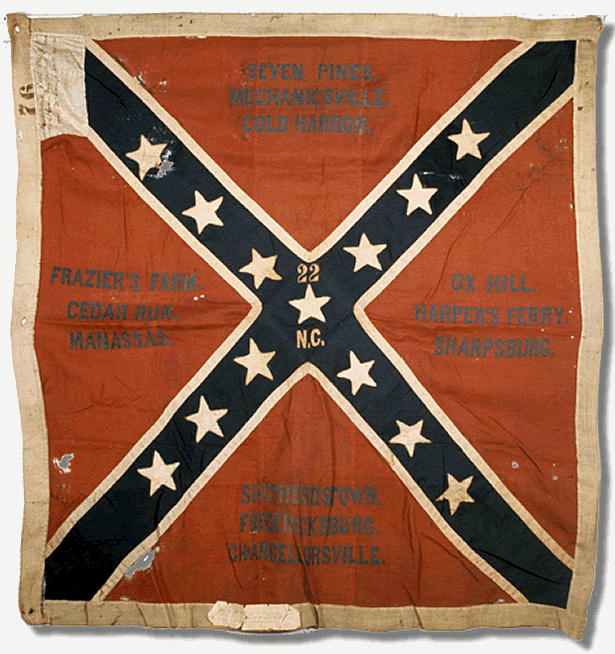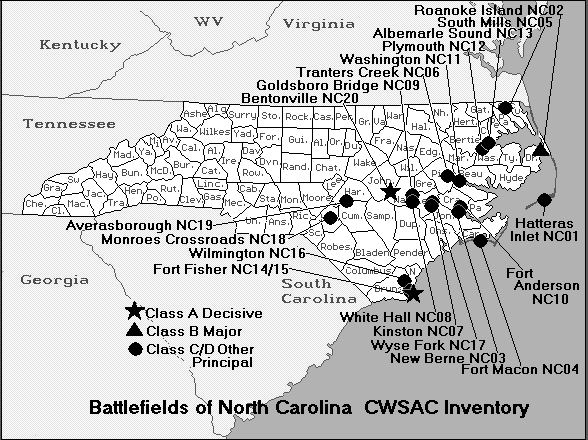|
22nd North Carolina Infantry Regiment
22nd Infantry Regiment, formerly the 12th Volunteers, completed
its organization near Raleigh,
North Carolina, in July 1861. The men were recruited in the counties of Caldwell,
McDowell, Surry, Ashe, Guilford, Alleghany, Caswell, Stokes, and Randolph.
With nearly 1,000 men, the unit was ordered to Virginia and assigned to the
Aquia District in the Department of Northern Virginia. Later it was brigaded under Generals
Pettigrew, Pender, and Scales. It fought with the army from Seven Pines to Cold Harbor, took its place in the Siege of Petersburg south of the James River, and ended the war at
Appomattox. In April 1862
this regiment contained 752 men, reported 161 casualties during the Seven Days Battles, had 6 killed and 57 wounded at Second Manassas, and 1 killed and 44 wounded at Fredericksburg. It lost 30 killed and 139 wounded at Chancellorsville, and of the 321 engaged at
Gettysburg over fifty percent were disabled. On April
9, 1865, it surrendered with 13 officers and 97 men. The field officers were Colonels James Conner, Thomas S. Galloway,
Jr., Charles E. Lightfoot, and James J. Pettigrew; Lieutenant Colonels Christopher C. Cole, R. H. Gray, John O. Long, and
William L. Mitchell; and Majors Laban Odell and W. Lee Russell.
22nd North Carolina Regimental Flag
| 22nd North Carolina Regimental Flag |

|
| (North Carolina Museum of History) |
This flag is a Third Bunting Army
of Northern Virginia Battle flag. It has battle honors painted in blue with the Regimental numbers painted in yellow in the
center. The 22nd North Carolina Troops, as part of Scales Brigade, lost these colors during the Pettigrew-Pickett-Trimble
Assault on July 3, 1863. The flag was returned to the State of North Carolina in 1905. Courtesy 26nc.org; North Carolina
Museum of History.
| 22nd North Carolina Infantry |

|
| 22nd North Carolina Regiment |
Recommended
Reading: Randolph Hornets in the Civil War: A History and Roster of Company M, 22nd North Carolina Regiment.
Description: This book conveys the history of the Randolph Hornets and of the company’s soldiers through both official
and personal accounts of the Civil War. Articles written by Sergeant John T. Turner in 1914 recalling his experiences with
the company are included as well as an in-depth history of the company battle flag, its capture, and its return to the county.
Continued below...
A complete roster of the company includes
genealogical information and short biographies for several of the men. The final chapter provides information about the local
reenactment group based on the company, whose performances provide a sense of the hardships of 19th century military life.
Advance to:
Recommended Reading: The Flags of Civil War North
Carolina. Description: Compiled and written by educator and
Civil War expert Glenn Dedmondt, The Flags Of Civil War North Carolina is a very straightforward
reference presenting photographs, color illustrations, descriptions and history of the titular flags that flew over North Carolina when it seceded from the Union. Each page or two-page
spread features the different flags of the various North Carolina
regiments. A meticulously detailed resource offering very specific information for history and civil war buffs, The Flags
Of Civil War North Carolina is a welcome contribution to the growing library of Civil War Studies and could well serve as
a template for similar volumes for the other Confederate as well as Union states. Great photos and illustrations! Continued
below...
Flags stir powerful emotions,
and few objects evoke such a sense of duty and love for the homeland. In April 1861, the first flag of a new republic flew
over North
Carolina. The state had just seceded from the union, and its citizens would soon have to fight for
their homes, their families, and their way of life. Each flag is meticulously detailed and scaled to perfection. The Flags
of Civil War North Carolina is the history of this short-lived
republic (which later joined the Confederacy), told through the banners that flew over its government, cavalry, and navy.
From the hand-painted flag of the Guilford Greys to the flag of the Buncombe Riflemen--made from the dresses
of the ladies of Asheville--this collection is an exceptional
tribute to the valiant men who bore these banners and to their ill-fated crusade for independence. About
the Author: Glenn Dedmondt, a lifelong resident of the Carolinas and member of the Sons of Confederate Veterans, shares
his passion for the past as a teacher of South Carolina
history. Dedmondt has also been published in Confederate Veteran magazine.
Recommended Reading: The Civil War
in the Carolinas (Hardcover). Description: Dan Morrill relates the experience of two quite different states bound together
in the defense of the Confederacy, using letters, diaries, memoirs, and reports. He shows how the innovative operations
of the Union army and navy along the coast and in the bays and rivers of the Carolinas affected
the general course of the war as well as the daily lives of all Carolinians. In the latter part of the war,
he describes how Sherman's operation cut out the heart of
the last stronghold of the South. Continued below...
The author offers fascinating
sketches of major and minor personalities, including the new president and state governors, Generals Lee, Beauregard, Pickett,
Sherman, D.H. Hill, and Joseph E. Johnston. Rebels and abolitionists, pacifists and unionists, slaves and freed men and women,
all influential, all placed in their context with clear-eyed precision. If he were wielding a needle instead of a pen, his
tapestry would offer us a complete picture of a people at war. Midwest Book: The Civil War
in the Carolinas by civil war expert and historian Dan Morrill (History Department, University of North Carolina at Charlotte,
and Director of the Charlotte-Mecklenburg Historical Society) is a dramatically presented and extensively researched survey
and analysis of the impact the American Civil War had upon the states of North Carolina and South Carolina, and the people
who called these states their home. A meticulous, scholarly, and thoroughly engaging examination of the details of history
and the sweeping change that the war wrought for everyone, The Civil War In The Carolinas is a welcome and informative addition
to American Civil War Studies reference collections.
Recommended Viewing: The Civil War - A Film by Ken Burns. Review: The
Civil War - A Film by Ken Burns is the most successful public-television miniseries in American history. The 11-hour Civil War didn't just captivate a nation,
reteaching to us our history in narrative terms; it actually also invented a new film language taken from its creator. When
people describe documentaries using the "Ken Burns approach," its style is understood: voice-over narrators reading letters
and documents dramatically and stating the writer's name at their conclusion, fresh live footage of places juxtaposed with
still images (photographs, paintings, maps, prints), anecdotal interviews, and romantic musical scores taken from the era
he depicts. Continued below...
The Civil War uses all of these devices to evoke atmosphere and resurrect an event that many knew
only from stale history books. While Burns is a historian, a researcher, and a documentarian, he's above all a gifted storyteller,
and it's his narrative powers that give this chronicle its beauty, overwhelming emotion, and devastating horror. Using the
words of old letters, eloquently read by a variety of celebrities, the stories of historians like Shelby Foote and rare, stained
photos, Burns allows us not only to relearn and finally understand our history, but also to feel and experience it. "Hailed
as a film masterpiece and landmark in historical storytelling." "[S]hould be a requirement for every
student."
Recommended Reading: The Life of Johnny Reb: The Common Soldier of the Confederacy (444
pages) (Louisiana State University Press) (Updated edition: November 2007) Description: The
Life of Johnny Reb does not merely describe the battles and skirmishes fought by the Confederate foot soldier. Rather,
it provides an intimate history of a soldier's daily life--the songs he sang, the foods he ate, the hopes and fears he experienced,
the reasons he fought. Wiley examined countless letters, diaries, newspaper accounts, and official records to construct this
frequently poignant, sometimes humorous account of the life of Johnny Reb. In a new foreword for this updated edition, Civil
War expert James I. Robertson, Jr., explores the exemplary career of Bell Irvin Wiley, who championed the common folk, whom
he saw as ensnared in the great conflict of the 1860s. Continued below...
About Johnny Reb:
"A Civil War classic."--Florida Historical Quarterly
"This book deserves to be on the shelf of every Civil War modeler and enthusiast."--Model
Retailer
"[Wiley] has painted with skill a picture of the life of the Confederate
private. . . . It is a picture that is not only by far the most complete we have ever had but perhaps the best of its kind
we ever shall have."--Saturday Review of Literature
Recommended Reading: Confederate Military History Of North Carolina: North
Carolina In The Civil War, 1861-1865. Description: The author, Prof. D.
H. Hill, Jr., was the son of Lieutenant General Daniel Harvey Hill (North Carolina
produced only two lieutenant generals and it was the second highest rank in the army) and his mother was the sister to General
“Stonewall” Jackson’s wife. In Confederate Military History Of North
Carolina, Hill discusses North Carolina’s massive task of preparing and
mobilizing for the conflict; the many regiments and battalions recruited from the Old
North State; as well as the
state's numerous contributions during the war. Continued below...
During Hill's
Tar
Heel State study, the reader begins with
interesting and thought-provoking statistical data regarding the 125,000 "Old
North State" soldiers that fought
during the course of the war and the 40,000 that perished. Hill advances with the Tar Heels to the first battle at Bethel, through numerous bloody campaigns and battles--including North Carolina’s
contributions at the "High Watermark" at Gettysburg--and concludes with Lee's surrender at
Appomattox.
Sources: Official Records of the Union and Confederate Armies; Walter Clark,
Histories of the Several Regiments and Battalions from North Carolina in the Great War 1861-1865; National Park Service: American
Civil War; National Park Service: Soldiers and Sailors System; Weymouth T. Jordan and Louis H. Manarin, North Carolina Troops,
1861-1865; and D. H. Hill, Confederate Military History Of North Carolina: North Carolina In The Civil War, 1861-1865.
|

